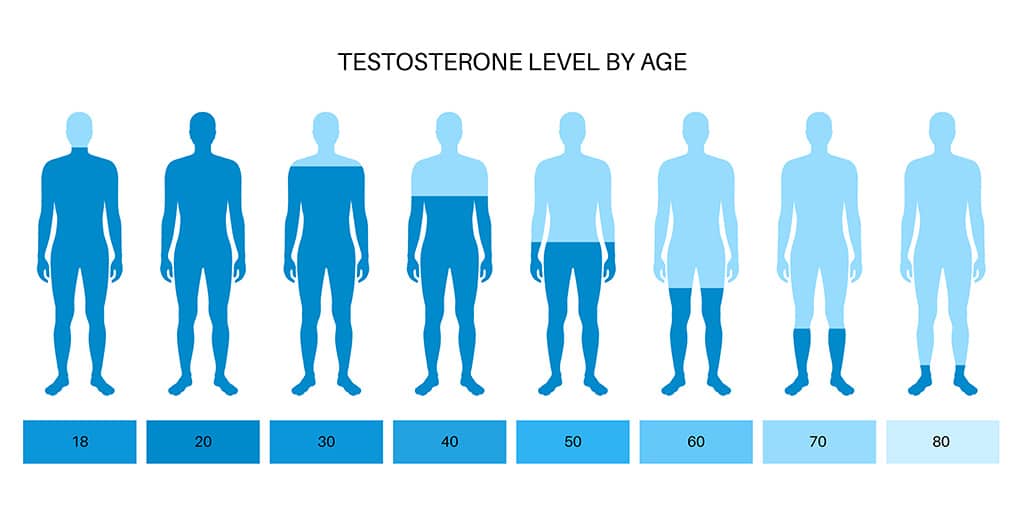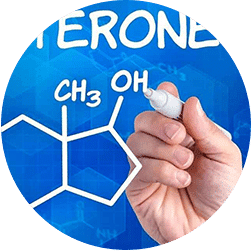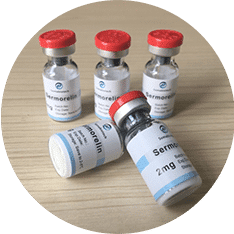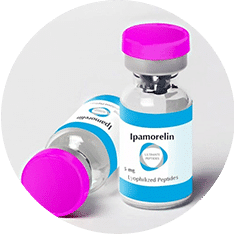
Unlock a More Youthful You With Testosterone Replacement Therapy In Little Ferry, NJ
Aging is inevitable, and for many, it signals the beginning of a new chapter - one where you cross off bucket list items and live life to the fullest, on your own terms. However, for some men, aging is a horrible prospect, filled with chronic fatigue, irritability, and inability to perform in the bedroom. If you're concerned about life in middle age and beyond, we've got great news: there are easy, proven steps that you can take to help stop the negative effect of aging.
Global Life Rejuvenation was founded to give men a new lease on life - one that includes less body fat, fewer mood swings, and more energy as you age. If you're ready to look and feel younger, it's time to consider TRT (testosterone replacement therapy), and growth hormone peptides. These therapies for men are effective, safe, and customized to fit your goals, so you can keep loving life as you get older.
TRT, and growth hormone peptide therapies bridge the gap between your old life and the more vibrant, happier version of you. With a simple click or call, you can be well on your way to a brighter future. After all, you deserve to be the one in charge of your wellness and health. Now, you have the tools to do so - backed by science and applied by our team of TRT and HRT experts with more than 13 years of experience.

Testosterone Replacement Therapy
- Unlock A More Youthful You With Testosterone Replacement Therapy In Little Ferry, NJ
- TRT and Anti-Aging Medicine for Men
- Common Symptoms of Low Testosterone
- Benefits of TRT and Anti-Aging Medicine for Men
- Fight Back Against Male Menopause
- Reverse Aging with Growth Hormone Peptides in Little Ferry, NJ
- Your New, Youthful Lease on Life Starts Here
TRT and Anti-Aging Medicine for Men in Little Ferry, NJ
For men, getting older comes with its perks, like living life on their own terms and not having to "sweat the small stuff" day in and day out. At the same time, there are aspects of aging that men dread, like hormonal changes. Yes, you read that right – men, not just women, go through hormonal changes as they age. For men, the biggest change involves a drop in testosterone.
Lower levels of testosterone can wreak havoc on a male's mind and body and when left untreated, can result in symptoms like:
- Erectile Dysfunction
- Depression
- Irritability
- Low Sex Drive
- Hair Loss
- Less Muscle Mass
- Problems Concentrating
Those symptoms are concerning, but with testosterone replacement therapy and anti-aging medicine, many males improve their quality of life with age. The good news is that TRT and anti-aging meds aren't only reserved for "old guys." In fact, there's no magic age at which men should start thinking about hormone replacement therapy. Everyone's body is different, so if you're experiencing the above conditions in your mid-30s, TRT could be a viable solution when you consult with a doctor.


What is Testosterone?
Testosterone is a crucial hormone for men and plays an important role throughout the male lifespan. Most of a male's testosterone is produced through the testicles. Also called the male sex hormone, testosterone starts playing its part during puberty.
When a male goes through puberty, testosterone helps males develop:
- Facial Hair
- Body Hair
- Deeper Voice
- Muscle Strength
- Increased Libido
- Muscle Density
As boys turn to men and men grow older, testosterone levels deplete naturally. Sometimes, events like injuries and chronic health conditions like diabetes can lower testosterone levels. Unfortunately, when a man loses too much T, it results in hypogonadism. When this happens, the testosterone must be replaced, or the male will suffer from symptoms like muscle loss, low libido, and even depression.

How Does TRT Work?
TRT is exactly what it sounds like: a treatment option for men that replaces testosterone so that your body regulates hormones properly and restores balance to your life. Also called androgen replacement therapy, TRT alleviates the symptoms that men experience with low T.
Originally lab-synthesized in 1935, testosterone has grown in popularity since it was produced. Today, TRT and other testosterone treatments are among the most popular prescriptions in the U.S.
Without getting too deep into the science, TRT works by giving your body the essential testosterone it needs to function correctly. As the primary androgen for both males and females, testosterone impacts many of the body's natural processes – especially those needed for overall health. For example, men with low T are more prone to serious problems like cardiovascular disease and even type-2 diabetes.
When your body quits making enough testosterone, it causes your health to suffer until a solution is presented. That's where TRT and anti-aging medicine for men can help. TRT helps balance your hormones and replenish your depleted testosterone. With time, your body will begin to heal, and many symptoms like low libido and irritability begin to diminish.

What Causes Low T?
For men, aging is the biggest contributor to lower testosterone levels, though there are other causes like obesity, drug abuse, testicular injuries, and certain prescribed medications. Sometimes, long-term health conditions like AIDS, cirrhosis of the liver, and kidney disease can lower testosterone levels.
When a man's testosterone levels drop significantly, it alters his body's ratio of estrogen and testosterone. Lower testosterone levels cause more abdominal fat, which in turn results in increased aromatase, which converts even more testosterone into estrogen.
If you're concerned that you might have low T, you're not alone. Millions of men in the U.S. feel the same way. The best way to find out if your testosterone is low is to get your levels tested.
For sustainable testosterone replacement therapy benefits, you must consult with hormone doctors and experts like those you can find at Global Life Rejuvenation. That way, you can find the root cause of your hormone problems, and our team can craft a personalized HRT plan tailored to your needs.
Common Symptoms of Low Testosterone
Are you used to blasting through a productive day and accomplishing all your daily goals? Do you find yourself losing muscle mass and the craving to be intimate with your partner? Does your partner complain about how irritable you have become? If you're not usually a curmudgeon, your body could be giving you a sign. It could be time to speak with a doctor about TRT and anti-aging medicine for men in Little Ferry, NJ.
If you're experiencing any of the following symptoms, you might be battling against low testosterone:

Low Sex Drive
One of the most common reasons that men choose TRT is because they have lost that "spark" with their partner. It's not easy for a man to hear that they're not performing like they used to. Intimacy is a powerful part of any relationship. When a once-healthy sex life dwindles, it can cause serious relationship issues.
The good news is that low libido doesn't have to be a permanent problem. TRT and anti-aging medicines help revert hormone levels back into their normal range. When this happens, many men have a more enjoyable life full of intimacy and sex drive.

Inability to Achieve and Maintain an Erection
Weak erections – it's an uncomfortable subject for many men in the U.S. to talk about. It's even worse to experience first-hand. You're in the midst of an intimate moment, and you can't do your part. Despite being perfectly normal, many men put blame and shame upon themselves when they can't achieve an erection. And while the inability to perform sexually can be caused by poor diet, obesity, and chronic health conditions, low testosterone is often a contributing factor.
Fortunately, weak erections are a treatable condition. The best way to regain your confidence and ability in bed is to speak with your doctor. Once any underlying conditions are discovered, options like TRT may be the best course of treatment.
Hair Loss

Loss of Strength and Muscle Mass
Do you find it harder and harder to work out and lift weights in the gym? Are you having problems lifting heavy items that you once had no problem lifting?
Recent studies show that when men are inactive, they lose .5% of muscle strength every year, from ages 25 to 60. After 60, muscle loss doubles every decade. While some muscle loss is common as men age, a significant portion can be tied to low testosterone levels. When a man's T levels drop, so does his muscle mass.
Testosterone is a much-needed component used in gaining and retaining muscle mass. That's why many doctors prescribe TRT Little Ferry, NJ, for men having problems with strength. One recent study found that men who increased their testosterone levels using TRT gained as much as 2.5 pounds of muscle mass.
Whether your gym performance is lacking, or you can't lift heavy items like you used to, don't blame it all on age. You could be suffering from hypogonadism.

Hair Loss
If you're like millions of other men in their late 20s and 30s, dealing with hair loss is a reality you don't want to face. Closely related to testosterone decline and hormone imbalances, hair loss is distressing for many men. This common symptom is often related to a derivative of testosterone called DHT. Excess amounts of DHT cause hair follicles to halt their production, causing follicles to die.
Because hair located at the front and crown is more sensitive to DHT, it grows slower than other follicles and eventually stops growing permanently. Thankfully, TRT and anti-aging treatments for men in Little Ferry, NJ, is now available to address hair loss for good.
While it's true that you can't change your genes, you can change the effects of low testosterone on your body. Whether you're suffering from thinning hair or hair loss across your entire head, TRT and other hormone therapies can stop hair loss and even reverse the process.

Gynecomastia
Also called "man boobs," gynecomastia is essentially the enlargement of male breast tissue. This increase in fatty tissue is often caused by hormonal imbalances and an increase in estrogen. For men, estrogen levels are elevated during andropause. Also called male menopause, andropause usually happens because of a lack of testosterone.
If you're a man between the ages of 40 and 55, and you're embarrassed by having large breasts, don't lose hope. TRT is a safe, effective way to eliminate the underlying cause of gynecomastia without invasive surgery. With a custom HRT and fitness program, you can bring your testosterone and estrogen levels back to normal before you know it.

Decreased Energy
Decreased energy was once considered a normal part of aging. Today, many doctors know better. Advances in technology and our understanding of testosterone show that low T and lack of energy often go hand-in-hand.
If you're struggling to enjoy activities like playing with your kids or hiking in a park due to lack of energy, it could be a sign of low T. Of course, getting tired is perfectly normal for any man. But if you're suffering from continual fatigue, a lack of enjoyment, or a decrease in energy, it might be time to speak with a doctor.
Whether you're having a tough time getting through your day or can't finish activities you used to love, TRT could help.

Lack of Sleep
A study from 2011 showed that men who lose a week's worth of sleep can experience lowered testosterone levels – as much as 15%, according to experts. Additional research into the topic found almost 15% of workers only get five hours of sleep (or less) per night. These findings suggest that sleep loss negatively impacts T levels and wellbeing.
The bottom line is that men who have trouble sleeping often suffer from lower testosterone levels as a result. If you find yourself exhausted at the end of the day but toss and turn all night long, you might have low T.
TRT and anti-aging medicines can restore your T levels back to normal, which can help you sleep better with proper diet and exercise.

Depression
You're feeling down about everything, and there's no solid explanation for why you're in such a crummy mood. Your daily life is great and full of success, but you can't help but feel unexcited and unmotivated. If you're experiencing symptoms like these, you may be depressed – and it may stem from low testosterone.
A research study from Munich found that men with depression also commonly had low testosterone levels. This same study also found that depressed men had cortisol levels that were 67% higher than other men. Because higher cortisol levels lead to lower levels of testosterone, the chances of severe depression increase.
Depression is a very real disorder and should always be diagnosed and treated by your doctor. One treatment option gaining in popularity is TRT for depression. Studies show that when TRT is used to restore hormone levels, men enjoy a lighter, more improved mood. That's great news for men who are depressed and have not had success with other treatments like anti-depression medicines, which alter the brain's chemistry.

Inability to Concentrate
Ask anyone over the age of 50 how their memory is, and they'll tell you it wasn't what it used to be. Memory loss and lack of concentration occur naturally as we age – these aren't always signs of dementia or Alzheimer's.
However, what many men consider a symptom of age may be caused by low testosterone. A 2006 study found that males with low T levels performed poorly on cognitive skill tests. These results suggest that low testosterone may play a part in reducing cognitive ability. If you're having trouble staying on task or remembering what your schedule is for the day, it might not be due to your age. It might be because your testosterone levels are too low. If you're having trouble concentrating or remembering daily tasks, it could be time to talk to your doctor.
Why? The aforementioned study found that participating men experienced improved cognitive skills when using TRT.

Weight Gain
Even though today's society is more inclusive of large people, few adults enjoy gaining weight as they age. Despite their best efforts, many men just can't shed the extra pounds around their midsections, increasing their risk of heart disease and cancer.
Often, male weight gain is caused by hormone imbalances that slow the metabolism and cause weight to pile on. This phase of life is called andropause and happens when there is a lack of testosterone in the body. Couple that with high cortisol levels, and you've got a recipe for flabby guts and double chins.
Fortunately, TRT treatments and physician-led weight loss programs can correct hormone imbalances and lead to healthy weight loss for men.
Benefits of TRT and Anti-Aging Medicine for Men in Little Ferry, NJ
The benefits of hormone replacement therapy for men are numerous. TRT not only grants relief from low-T symptoms but can help give protection against age-related diseases. Additionally, doctors now recognize male testosterone as an important role in alleviating depression.
Some of the most exciting benefits of TRT can include:
- Reduction in Body Fat
- Increased Strength
- More Muscle Mass
- More Energy
- Lower Risk of Erectile Dysfunction
- Higher Sperm Production
- Healthy Reproductive Tissues
- Lower Risk of Heart Disease and Diabetes
- Lower Risk of Anxiety
- Lower Risk of Depression


Fight Back Against Male Menopause
Because men do not go through a specific period of hormonal changes like women do (called menopause), many doctors refer to "male menopause" as androgen decline. This is just another term for low testosterone, but like female menopause, the symptoms can be serious and affect your quality of life.
The best way to fight back against male menopause is with male HRT treatment from Global Life Rejuvenation. We provide the following HRT treatments for men:
- Testosterone Replacement Therapy (TRT)
- Sermorelin (Sermorelin Acetate)
- Human Growth Hormone (HGH)
Our treatment options are personalized for your body and are available as creams, gels, injectables, and implantable pellets. To find out if testosterone replacement therapy is safe for you, contact Global Life Rejuvenation today to schedule your comprehensive testing and anti-aging treatment consultation.
Reverse Aging with Growth Hormone Peptides in Little Ferry, NJ
Growth hormone peptides are an innovative therapy that boosts the natural human growth hormone production in a person's body. These exciting treatment options help slow down the aging process and give you a chance at restoring your youth.

What is Sermorelin?
Sermorelin is a synthetic hormone peptide, like GHRH, which triggers the release of growth hormones. When used under the care of a qualified physician, Sermorelin can help you lose weight, increase your energy levels, and help you feel much younger.

Benefits of Sermorelin
Human growth hormone (HGH) therapy has been used for years to treat hormone deficiencies. Unlike HGH, which directly replaces declining human growth hormone levels, Sermorelin addresses the underlying cause of decreased HGH, stimulating the pituitary gland naturally. This approach keeps the mechanisms of growth hormone production active.
Benefits of Sermorelin include:
- Better Immune Function
- Improved Physical Performance
- More Growth Hormone Production
- Less Body Fat
- Build More Lean Muscle
- Better Sleep

What is Ipamorelin?
Ipamorelin helps to release growth hormones in a person's body by mimicking a peptide called ghrelin. Ghrelin is one of three hormones which work together to regulate the growth hormone levels released by the pituitary gland. Because Ipamorelin stimulates the body to produce growth hormone, your body won't stop its natural growth hormone production, which occurs with synthetic HGH.
Ipamorelin causes growth hormone secretion that resembles natural release patterns rather than being constantly elevated from HGH. Because ipamorelin stimulates the natural production of growth hormone, our patients can use this treatment long-term with fewer health risks.

Benefits of Ipamorelin
One of the biggest benefits of Ipamorelin is that it is suitable for both men and women. It provides significant short and long-term benefits in age management therapies, boosting patients' overall health, wellbeing, and outlook on life. When growth hormone is produced by the pituitary gland using Ipamorelin, clients report amazing benefits.
Some of those benefits include:
- Powerful Anti-Aging Properties
- More Muscle Mass
- Less Unsightly Body Fat
- Deep, Restful Sleep
- Increased Athletic Performance
- More Energy
- Less Recovery Time for Training Sessions and Injuries
- Enhanced Overall Wellness and Health
- No Significant Increase in Cortisol
Your New, Youthful Lease on Life Starts Here
Whether you are considering our TRT services, HRT for women, or our growth hormone peptide services, we are here to help. The first step to turning back the hand of time starts by contacting Global Life Rejuvenation.
Our friendly, knowledgeable TRT and HRT experts can help answer your questions and walk you through our procedures. From there, we'll figure out which treatments are right for you. Before you know it, you'll be well on your way to looking and feeling better than you have in years!
 866-793-9933
866-793-9933
Request a Consultation
Latest News in Little Ferry, NJ
Several areas in NJ designated by FEMA as ‘disaster resilience zones’
Kimberlee Bongardhttps://www.njspotlightnews.org/2023/09/fema-designates-several-nj-areas-community-disaster-resilience-zones/
Several flood-prone areas in New Jersey have been earmarked by federal officials to receive additional support to protect communities against climate change.The Federal Emergency Management Agency designated 483 census tracts nationwide as Community Disaster Resilience Zones earlier this month.FEMA listed eight zones in New Jersey, including parts of Bergen, Hudson, Atlantic and Cape May counties. The eight zones are in Little Ferry, Moonachie, Kearny, Atlantic City, Pleasantville, Wildwood, North Wildwood and Commercial Townsh...
Several flood-prone areas in New Jersey have been earmarked by federal officials to receive additional support to protect communities against climate change.
The Federal Emergency Management Agency designated 483 census tracts nationwide as Community Disaster Resilience Zones earlier this month.
FEMA listed eight zones in New Jersey, including parts of Bergen, Hudson, Atlantic and Cape May counties. The eight zones are in Little Ferry, Moonachie, Kearny, Atlantic City, Pleasantville, Wildwood, North Wildwood and Commercial Township.
FEMA will use the designated zones to prioritize grant funding and to increase the federal share of the cost of resiliency projects in those areas.
“The priority is to assist communities that are at the highest risk to climate impacts and have the most need for assistance,” Victoria Salinas, FEMA associate administrator for resilience, said during a recent call with reporters.
Risk index
According to FEMA, no new source of funding is tied to the Resilience Zone list. Rather, communities on it will be prioritized for grant funding not just from FEMA but from other federal agencies.
FEMA made the designations after the Community Disaster Resilience Zones Act, signed into law last year, instructed the agency to identify areas at high risk from the impacts of climate change and other natural hazards.
To compile the list, FEMA used its National Risk Index, which rates census tracts based on their vulnerability to different natural hazards, including coastal flooding, hurricanes, wildfires and drought. FEMA also considered socioeconomic factors that can impact a community’s disaster resilience. The agency identified the top 50 census tracts with the highest risk for all natural hazards nationwide, as well as the top 1% for each state.
In Bergen County, the towns of Moonachie and Little Ferry, among the hardest hit by Superstorm Sandy, were identified as Community Disaster Resilience Zones. Extreme flooding remains a threat for towns along the Hackensack River. Coincidentally, the state Department of Environmental Projection last week announced the awarding of a $46.6 million construction contract related to Rebuild by Design Meadowlands, a flood resilience project to protect Little Ferry and neighboring towns from future storms. The funding comes from a federal grant program.
The first phase of construction, which includes installation of a pump station in Little Ferry to reduce storm-surge flooding and improve drainage within the Losen Slote Creek watershed during heavy rain storms, is expected to begin at the end of October.
Need for protection
“We are happy that FEMA is going to give us an opportunity to be able to apply for and receive grants to further strengthen our infrastructure and flood mitigation plans,” said Little Ferry Mayor Mauro Raguseo. “The Rebuild by Design project starting and the designation by FEMA hopefully means that we will have even more funds available to protect our community.”
Most of the Community Disaster Resilience Zones listed for New Jersey are in coastal areas.
‘We are happy that FEMA is going to give us an opportunity to be able to apply for and receive grants to further strengthen our infrastructure and flood mitigation plans.’ — Little Ferry Mayor Mauro Raguseo
Vince Jones, the director of the Office of Emergency Management for Atlantic County, said resiliency efforts are critical in coastal communities like Atlantic City that are seeing increased high-tide flooding in low-lying areas, even on sunny days without rainfall.
The National Oceanic and Atmospheric Administration released its annual high-tide flooding outlook last month, which found the mid-Atlantic region is likely to see nine to 14 high-tide flood days between May 2023 and April 2024, about three times as many as occurred in 2000. Atlantic City could see as many as 15 high-tide flood days during that period, according to NOAA. High-tide flooding happens when tides reach between 1 to 2 feet above the daily average high tide.
“Thankfully they’ve realized our vulnerabilities and they’ve finally identified it,” said Jones. “Especially in these couple areas, where the towns themselves really don’t have the funding to even begin to do some of the projects that they need to try to make themselves resilient.”
Jacques Howard, Atlantic City’s director of planning and development, said he hopes additional funds from FEMA could be used to rebuild deteriorating bulkheads and raise homes in back-bay neighborhoods that are vulnerable to flooding.
“The elevation of these homes oftentimes is $100,000 plus. It’s not cheap,” Howard said. “These funds should be able to facilitate those property owners that in the past may not have been able to raise their homes.”
Funding realities
Jones said municipalities are awaiting more information regarding what grant opportunities will be available to them under the designation.
“We’re hoping that there’s different kinds of fundings that comes out — some for flood protection, maybe some for residential or community-based programs. We’re hoping that when you talk about the money, it’s a lot of different categories that we can avail ourselves [of],” Jones said.
FEMA officials said they hope that nonprofits, philanthropies, businesses and others in the private sector will use the zones to identify where to focus funding or resilience efforts.
More zones will be announced this fall and another round of designations will be made next year based on updates to the National Risk Index. The initial designation as a Community Disaster Resilience Zone lasts five years.
Little Ferry school built in 1914 will be demolished this summer. Here's why
North Jersey Media Grouphttps://www.northjersey.com/story/news/bergen/little-ferry/2023/06/08/little-ferry-nj-school-demolished-summer/70297177007/
3-minute read Megan BurrowNorthJersey.comLITTLE FERRY — Washington School, the 109-year-old elementary school that closed five years ago due to its deteriorating condition, will be demolished this summer to make way for a new school building.Officials plan to ask voters in a referendum sometime next year to fund the construction of a new middle schoo...
3-minute read
NorthJersey.com
LITTLE FERRY — Washington School, the 109-year-old elementary school that closed five years ago due to its deteriorating condition, will be demolished this summer to make way for a new school building.
Officials plan to ask voters in a referendum sometime next year to fund the construction of a new middle school at the Liberty Street site.
“You have to remember this building is over 100 years old,” said Superintendent Frank Scarafile, who is leaving the district next month after 18 years. “We’ve looked at every angle to preserve the building. It’s part of Little Ferry's history. But we really need to look forward at what the community needs.”
Washington School closed in June 2018 after the district spent more than $130,000 on emergency repairs, when officials learned that it would take millions more to fix the aging building.
An architect and engineer were hired to inspect classrooms after part of a ceiling fell in a room the previous December. More compromised ceilings were found, each costing $12,000 to $15,000 to replace.
The school was severely damaged more than a decade ago during Superstorm Sandy, which left the school's gym, five classrooms and a computer lab under 4 feet of water. Nike funded the cost of a new waterproof gym floor, and hundreds of thousands of dollars was spent on repairs to reopen the damaged classrooms, much of it covered by insurance.
But the building’s issues didn’t end there: The roof leaked, its classrooms were flood-prone, the walls hid asbestos and the school did not meet accessibility standards.
At the time, a feasibility study put the cost to rehabilitate the building at more than $9 million. The price would likely be much higher today, officials said.
The brick building’s 13 classrooms are outdated and are unable to meet the district's needs as it grows, said Matthew Perrapato, the incoming superintendent. Plans for a new, larger building include science labs, modern classrooms and a cafeteria with a working kitchen.
“Rehabbing Washington would be expensive, and it also wouldn’t give us what we need when the work is complete,” he said. “We need more classrooms, science labs and common space areas.”
The district will award a bid early next month to a contractor to tear down the building and clear the site. The work will take about four months to complete, officials said.
Since 2018, the district’s first and second graders have been learning in 16 modular classrooms near Memorial School, just across the street from Washington. The classes also house some of the district’s special education programs.
More:Bergen County 2023 primary election results
Generations of borough children have passed through Washington School’s doors since it opened in 1914. Longtime residents have fond memories of their early years spent there: playing games on creaky wooden floors, kindergarten classrooms with fireplaces, and Friday night dances in the gymnasium.
Decades ago, students would line up according to gender outside separate girls' and boys' entrances, marked with embossed stone signs above the doors.
Officials say they want to honor that past while looking toward the future. Residents are invited to share photos and memories at lfboe.org/LittleFerryFuture. The school’s cornerstone will be preserved and used in the construction of the new building, said Victoria Bradley, the Board of Education president.
Earlier plans to ask voters to fund a new K-6 school at the site and eventually turn Memorial School into a junior-senior high school were progressing, “but then COVID hit and knocked everything off the rails,” Scarafile said.
Those plans changed again last year when Little Ferry was awarded a state grant for a free pre-K program. In September, 85 students will attend the program, about half of the borough’s pre-kindergarten-age population.
The district has five years to expand to meet the needs of 90% of eligible 3- and 4-year-olds, according to state requirements.
Current plans call for a new middle school at the Washington School site, and for Memorial School to serve students in pre-K through fifth grade.
“This will be an exciting journey for the entire community,” Bradley said. “It’s an investment in the future.”
A referendum will likely be put to voters next spring. The Hackensack firm RSC Architects is working on the new building’s design. Officials say it is too early to know how much the project will cost.
Earlier plans, also designed by the firm in 2019, for a three-story, 83,000-square-foot building had a price tag of roughly $30 million, with about a third of the cost covered by the state.
Little Ferry pays Ridgefield Park more than $17,000 annually for each of its 275 high school students to attend Ridgefield Park Junior-Senior High School. Officials still hope eventually to bring borough high schoolers back to the district but are taking it one step at a time.
“It’s a process. We need to take care of these buildings first and get the students out of the modulars,” Perrapato said. “These conversations are happening simultaneously, but right now we need to get the elementary and middle school students in their own buildings and then look at next steps.”
Remember Sandy? This Meadowlands project aims to reduce such flooding
Sammy Gibbonshttps://www.northjersey.com/story/news/2023/09/22/meadowlands-hoboken-nj-funds-protect-areas-flooding-sandy/70924390007/
2-minute readNorth Jersey’s flood protection plans took a key step forward last week as the state announced new contracts totaling nearly $298 million to support two major flood-resilience projects, one in the Meadowlands and another in Hoboken and parts of Jersey City and Weehawken.The Meadowlands communities that will benefit include Little Ferry, Carlstadt, Moonachie, South Hackensack and Teterboro.Both projects aim to protect the areas from flooding caused by severe storms and rising sea levels...
2-minute read
North Jersey’s flood protection plans took a key step forward last week as the state announced new contracts totaling nearly $298 million to support two major flood-resilience projects, one in the Meadowlands and another in Hoboken and parts of Jersey City and Weehawken.
The Meadowlands communities that will benefit include Little Ferry, Carlstadt, Moonachie, South Hackensack and Teterboro.
Both projects aim to protect the areas from flooding caused by severe storms and rising sea levels, issues tied to worsening climate change impacts. The contracts were announced by Shawn LaTourette, commissioner of the state Department of Environmental Protection, as part of Climate Week, designed to educate the public about climate change and actions to address its effects.
The Meadowlands project aims to lower the risk of rainfall flooding and to accelerate recovery times from storm surge flooding within the Losen Slote Creek watershed in Little Ferry and surrounding towns, the DEP said.
Response to Superstorm Sandy
Rebuild by Design Meadowlands was created after Superstorm Sandy to reinforce flood resiliency in Little Ferry and nearby towns also hit hard by Sandy in 2012. The storm surge caused the Hackensack River to flood and “took over 70% of the town,” Little Ferry Mayor Mauro Raguseo told NorthJersey.com. Over a decade later, the low-lying and densely populated area remains vulnerable to flooding, especially given the growing impacts of climate change.
The company that was awarded a $45.6 million contract, Union Paving & Construction, will begin construction this fall. It plans to install new infrastructure to improve drainage in the watershed. The team also plans to build a second pump station and make channel improvements.
More:Corps of Engineers picks $52B floodgate plan to protect Meadowlands from Sandy-like storms
Due to old age, the area’s network of drainage channels and ditches does not provide adequate drainage after heavy rains, a project fact sheet says. Construction crews will deepen and widen the East Riser Ditch, remove sediment and debris, and add native plants to the embankment to enhance biodiversity.
Union will also replace the railroad bridge over the East Riser Ditch in Carlstadt, which is one portion of the project among others that may temporarily affect traffic in the area.
More:A decade after Sandy, devastated Meadowlands towns still adding defenses, still vulnerable
“When completed, this project will have a measurable impact in preventing flooding in a large area of our community that has been prone to rising water in heavy rainstorms,” Raguseo said. “Like any major infrastructure construction project there may be detours and disturbances for a period of time, but it will certainly be worth it in the end when we see the final result.”
With enough funds, the Meadowlands project may also include a new park and green infrastructure designed for municipally owned buildings in the area, the project’s webpage says.
Hoboken project along the Hudson
The Hoboken project along the Hudson River will involve building more than 9,000 linear feet of resistance structures to serve as barriers during high tides and storm surges. The $251 million contract will also cover installation of a comprehensive stormwater drainage system.
The financial push moves these projects along after a nine-year planning process that involved extensive community engagement. The DEP and project teams are working with local officials to ensure that their work causes minimal traffic and quality-of-life disruptions, the DEP said.
The public can learn more about the projects and sign up to receive updates about topics like construction and related meetings on the Department of Environmental Protection’s Rebuild by Design webpage.
Capodagli Property Company Secures $71M to Complete 110 Bergen Turnpike in Little Ferry, New Jersey
Sebastian Morrishttps://newyorkyimby.com/2021/11/%E2%80%8B%E2%80%8B%E2%80%8B%E2%80%8B%E2%80%8Bcapodagli-property-company-secures-71m-to-complete-110-bergen-turnpike-in-little-ferry-new-jersey.html
Capodagli Property Company recently secured $71 million in construction financing to complete a new residential property at 110 Bergen Turnpike in Little Ferry, New Jersey. When complete, the property will comprise 294 apartments spread across two buildings.Renderings of the property appear to reveal a ground-floor retail component with the residential volume positioned above. The façade will comprise alternating white metal cladding and ...
Capodagli Property Company recently secured $71 million in construction financing to complete a new residential property at 110 Bergen Turnpike in Little Ferry, New Jersey. When complete, the property will comprise 294 apartments spread across two buildings.
Renderings of the property appear to reveal a ground-floor retail component with the residential volume positioned above. The façade will comprise alternating white metal cladding and tan paneling. The developer has not confirmed the property’s residential amenity package.
SCALE Lending, a Slate Property Group affiliate, provided the financing package. This loan marks the latest closing for SCALE Lending, one of the most active lenders in the New York metropolitan market for construction financing, with more than $1 billion lent over the last 18 months.
The transaction was arranged by Greystone Capital Advisors.
“Deals like 110 Bergen Turnpike demonstrate SCALE’s ability to adapt quickly to expanding markets as we continue our strong growth throughout the New York Metropolitan area,” said Martin Nussbaum, co-founder and principal of Slate Property Group. “This deal is the latest in a series of promising opportunities as we build upon our presence in new and exciting markets. We are proud of our relationships with prominent developers who are looking to expand their footprint and know SCALE is able to help them achieve their goals.”
Subscribe to YIMBY’s daily e-mail
Follow YIMBYgram for real-time photo updates Like YIMBY on Facebook Follow YIMBY’s Twitter for the latest in YIMBYnews
Work is nearing completion on 30 West 39th Street, 27-story hotel tower in Midtown, Manhattan. Designed by Peter Poon Architects and developed by Fortuna Realty, the 323-foot-tall structure will yield 133,500 square feet and 330 rooms. Leeding Builders Group, LLC is the general contractor for the property, which is located between Fifth and Sixth Avenues, a block south of Bryant Park.
Since our last update in February, work has wrapped up on the upper portion of the tower and shifted to the podium, which is in the process of receiving its final cladding behind scaffolding and netting.
The gaps between the perimeter columns in the podium have been enclosed with mechanical ventilation grilles and the concrete walls are lined with a yellow waterproof membrane. This part of the edifice was still exposed back in our last update. At the very top of the building are gray panels going up to the flat roof parapet and a row of six large square windows on the main northern elevation. These appear less transparent than the floor-to-ceiling glass curtain wall that makes up the majority of the façade below.
The blank eastern and western sides of the structure are also fully enclosed in their final gray surface. The sidewalk scaffolding is still up, though we can expect this to be dismantled in the coming months with the envelope above now largely completed.
30 West 39th Street. Photo by Michael Young
Few details about the interior have been announced, though YIMBY last reported that guest amenities will include a ground-floor restaurant, a lounge, a fitness center, and a business center. The nearest subways are the B, D, F, M and 7 trains at the 42 St-Bryant Park station to the north along Sixth Avenue. This station now has a new below-grade walking tunnel for a free transfer to the Shuttle from 6:00 PM to 11:59 PM, and further subterranean access to the 1, 2, 3, N, Q, R, and W trains at the Times Square-42 St station. The A, C, E, and buses at the 42 St-Port Authority Bus Terminal station is also nearby on Eighth Avenue.
A revised completion and opening date is also unclear, though it’s conceivable to see the property up and running sometime in the first half of 2022.
Subscribe to YIMBY’s daily e-mail
Follow YIMBYgram for real-time photo updates Like YIMBY on Facebook Follow YIMBY’s Twitter for the latest in YIMBYnews
Little Ferry's proposal for new school may get September vote
Megan Burrowhttps://www.northjersey.com/story/news/bergen/little-ferry/2019/03/21/little-ferrys-nj-new-elementary-school-could-get-september-vote/3222972002/
LITTLE FERRY — Borough education officials are preparing to ask voters to support building a new elementary school to replace Washington School, which closed last year due to its deteriorating condition.The proposed new school is part of a larger plan to turn Memorial School — an elementary school directly...
LITTLE FERRY — Borough education officials are preparing to ask voters to support building a new elementary school to replace Washington School, which closed last year due to its deteriorating condition.
The proposed new school is part of a larger plan to turn Memorial School — an elementary school directly across the street — into a junior-senior high school. Little Ferry high school students attend Ridgefield Park Junior-Senior High School, at a cost of about $5.5 million a year to the Little Ferry district.
“It is really time to look at this building and not let it sit,” Frank Scarafile, the schools superintendent, said at a borough Planning Board meeting Wednesday night. "If we’re going to move toward a high school, this is the time."
The three-story, 83,000-square-foot building, designed by the Hackensack firm RSC Architects, would have 38 classrooms, a library, a cafeteria and a gymnasium for the district’s pre-K through sixth-grade students.
The school, which would be built above the flood plain at the site of Washington School on Liberty Street, would cost an estimated $30 million, said Ken Mihalik, an architect with the firm. A courtyard for outdoor play would sit in the center of the U-shaped building.
About 30 percent of the cost could be covered by the state, Scarafile said.
The referendum would likely be held in late September, one of four times during the year such a vote can take place.
Before the vote, Scarafile said he plans to hold a series of community meetings to explain the plan to residents and address concerns.
Washington School closed in June after the district spent more than $130,000 on emergency repairs to the 105-year-old building.
The repairs were necessary after a plaster ceiling in a classroom collapsed and an inspection revealed that ceilings in several other classrooms also needed replacement.
The school's problems go beyond the deteriorating ceilings, officials said. The roof of the school leaks, classrooms flood, asbestos lies behind the walls and the electrical system needs an upgrade.
Since September, the district's third- and fourth-graders have been attending school in 16 modular classrooms next to Memorial School. Those classrooms could eventually be used by special education students who are currently sent to schools out of the district, Scarafile said.
Little Ferry:Kimchi Smoke to open new location in H Mart in Little Ferry
Referendum:Glen Rock approves $14.7 million school proposal
Development:The Record's former headquarters in Hackensack to become luxury apartments, retail
The cost to rehabilitate Washington School would be about $9.3 million, according to a feasibility study the district conducted after it closed.
State officials will examine the study and compare the cost with the new school’s price tag when determining whether Little Ferry can move forward with the referendum.
Once that decision is made, the state Department of Education will study the district’s request to bring its high school students back to Little Ferry.
“We’re not looking to take anything from Ridgefield Park, but we want the opportunity to educate our own kids,” Scarafile said. “We’re sending $5.5 million and we have no say on how that is spent.”
This year, the per-pupil cost to send a student to the regional high school is $14,300, up from $13,200 last year.
“If we don’t start thinking about the future here, we’re going to be indebted to Ridgefield Park, it’s going to affect the education of our kids here and we won’t be able to afford to do what we want to do,” Scarafile said.
The district will wait to get an answer from the state on withdrawing its students from Ridgefield Park before moving forward with construction.
If that plan gains approval, the elementary students at Memorial School and in the modular classrooms would move into the new building. Memorial would be renovated for use as a junior-senior high school.
If the state nixes the plan, the proposed building’s design would be scaled back, Scarafile said.
Email: [email protected]
Disclaimer:


